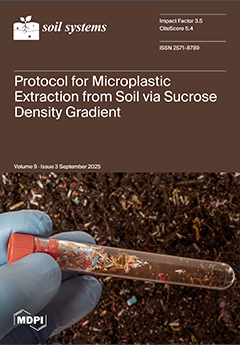Soil moisture plays a critical role in the global water cycle, the exchange of matter and energy within ecosystems, and the movement of water in plants. Accurate monitoring of soil moisture is essential for drought early warning systems, irrigation decision-making, and crop growth
[...] Read more.
Soil moisture plays a critical role in the global water cycle, the exchange of matter and energy within ecosystems, and the movement of water in plants. Accurate monitoring of soil moisture is essential for drought early warning systems, irrigation decision-making, and crop growth assessment. The use of drone-based multispectral remote sensing technology for estimating the soil moisture content offers advantages such as wide coverage, high accuracy, and efficiency. However, the soil background can often interfere with the accuracy of these estimations. In specific environments, such as areas with strong winds, removing soil background noise may not necessarily enhance the precision of estimates. This study utilizes unmanned aerial vehicle (UAV) multispectral imagery and employs a vegetation index threshold method to remove soil background noise. It systematically analyzes the response relationship between spectral reflectance, spectral indices, and the soil moisture content in the top 0–10 cm layer of alfalfa; constructs K-Nearest Neighbors (KNN), Random Forest Regression (RFR), ridge regression (RR), and XG-Boost inversion models; and comprehensively evaluates model performance. The results indicate the following: (1) The XG-Boost model validation set had the highest R
2 value (0.812) when spectral reflectance was used as the input variable, which was significantly better than the other models (R
2 = 0.465 to 0.770), and the RFR model validation set had the highest R
2 value when the spectral index was used as the input variable (0.632), which was significantly better than the other models (R
2 = 0.366 to 0.535). (2) After removing soil background noise, the accuracy of the soil moisture estimates for each model did not show significant changes; specifically, the R
2 value for the XG-Boost model decreased to 0.803 when using spectral reflectance as the input, and the R
2 value for the RFR model dropped to 0.628 when using spectral indices. (3) Before and after removing the soil background noise, the spectral reflectance can provide more accurate data support for the inversion of the soil moisture content than the spectral index, and the XG-Boost model is the most effective in the inversion of the soil moisture content when using the spectral reflectance as the input variable. The research findings provide both theoretical and technical support for the retrieval of the surface soil moisture content in alfalfa using drone-based multispectral remote sensing. Additionally, they offer evidence that validates large-scale soil moisture remote sensing monitoring.
Full article





